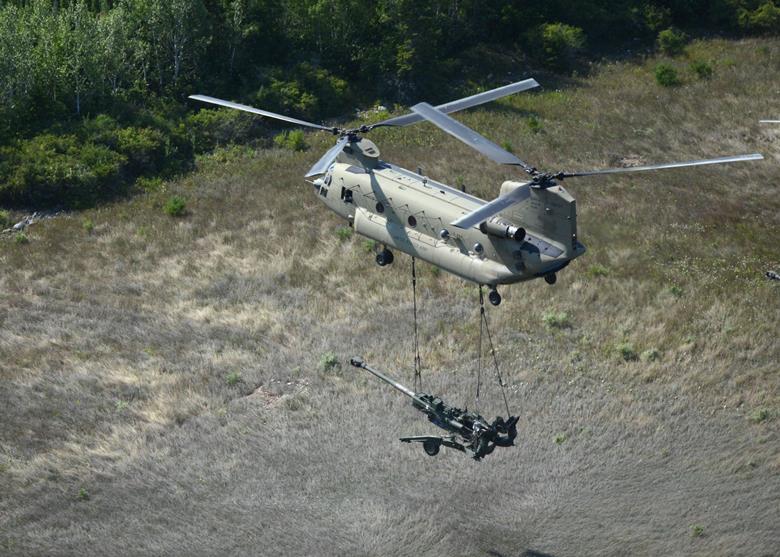Aerospace
Germany Secures Second-Largest Chinook Helicopter fleet in NATO, Strengthening Defense Capabilities

In a significant development for Germany’s defense capabilities, the nation is poised to become home to the second-largest helicopter force within NATO. This announcement follows the recent procurement of 60 Chinook helicopters, a strategic move that underlines Germany’s commitment to bolstering its military readiness and enhancing its role within the North Atlantic Treaty Organization.
German Air Force Chief Ingo Gerhartz announced this groundbreaking advancement during a press conference on Friday, shedding light on the nation’s ambitious plans for fortifying its aerial prowess. In a package deal that may cost up to 8 billion euros ($8.7 billion), according to Reuters last month, Germany will purchase 60 Chinook helicopters from Boeing. This price would also include the infrastructure required to support the aircraft.
According to Gerhartz, “We will be the second largest helicopter nation in NATO after the United States.” At the Holzdorf/Schoenewalde location in eastern Germany, where 1,000 more soldiers would also be stationed, over 50 Chinook helicopters will be based, according to Gerhartz. “The Schoenewalde site will play a unique key role for the Air Force, the entire Bundeswehr, and Germany’s security,” he declared.
Germany’s Condor airline with a new brand identity(Opens in a new browser tab)
While Germany’s helicopter force will soon stand as the second-largest within NATO, the nation remains committed to diplomatic and peaceful solutions to global challenges. The strengthened military capabilities are seen as a deterrent to potential aggressors, fostering an environment of security and stability that benefits not only Germany but the entire NATO alliance.

Aerospace
Boeing Transfers Rocket Stage to NASA, Paving Way for Human Moon Mission

Boeing has achieved a significant milestone by providing NASA with the second core stage of the Space Launch System (SLS) rocket.
This crucial component, crafted at NASA’s Michoud Assembly Facility (MAF), is set to propel the Artemis II crew into lunar orbit, marking humanity’s return to deep space after a 50-year hiatus.
The monumental Boeing-built rocket stage, the largest element of the Artemis II mission, will embark on a journey aboard the Pegasus barge, traveling 900 miles to NASA’s Kennedy Space Center.
Comparison of two legendary aircraft B777x vs B747 aircraft:Click here
Upon arrival, it will be meticulously integrated with other essential Artemis II components, including the upper stage, solid rocket boosters, and NASA’s Orion spacecraft within the iconic Vehicle Assembly Building. This intricate integration process is a vital step toward the eagerly anticipated Artemis II launch, slated for 2025.
“Boeing-built products helped land humankind on the moon in 1969, and we’re proud to continue that legacy through the Artemis generation,” remarked Dave Dutcher, vice president and program manager for Boeing’s SLS program. “Together, with NASA and our industry partners and suppliers, we are building the world’s most capable rocket and paving the way to deep space through America’s rocket factory in New Orleans.”
NASA, Lockheed Martin Reveal X-59 Quiet Supersonic Aircraft:Click here
The delivery of Core Stage 2 marks a significant achievement in the evolution of the SLS rocket. Towering over 200 feet and powered by four RS-25 engines, this core stage, coupled with two solid-fueled booster rockets, will generate a staggering 8.8 million pounds of thrust. This immense power is crucial to launching Artemis II and future missions into the vast expanse of space.
The SLS rocket stands unparalleled in its capability to transport both crew and substantial cargo to the moon and beyond in a single launch. Its extraordinary capacity will facilitate the delivery of human-rated spacecraft, habitats, and scientific missions to destinations including the moon and Mars, ushering in a new era of space exploration.
-

 Travel1 week ago
Travel1 week agoAir India to Expand US Operations with Three New Routes After a Decade
-

 Travel2 weeks ago
Travel2 weeks agoWhy We Should Avoid These Stamps in a Passport
-

 Airlines1 month ago
Airlines1 month agoInvestigations Reveal Fake Chinese Titanium in Boeing and Airbus Jets
-

 Tech4 weeks ago
Tech4 weeks agoChina’s CATL Plans 1,800-Mile Electric Plane Launch by 2027
-

 Airport3 days ago
Airport3 days agoTop 10 Largest Airports in the World by Size
-

 Aerospace4 weeks ago
Aerospace4 weeks agoChina’s Fighter Jets Turn Wings into Autonomous Drones
-

 Airlines4 days ago
Airlines4 days agoAir India Rolls Out A350s for Delhi-New York JFK and Newark Routes
-

 Defence3 weeks ago
Defence3 weeks agoBoeing Enhances Chinook with New Engines and Block II Upgrades at $96 Million







